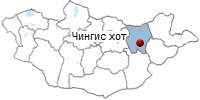Chinggis City. Ondorkhaan.
THE REGIONS OF MONGOLIA
KHENTII AIMAG
Chinggis City (Öndörkhaan)


Khentii aimag, a captivating region in northeastern Mongolia, boasts breathtaking landscapes of rolling steppes, dense forests, and majestic
mountains. This historical province is renowned as the birthplace of Genghis Khan and offers a unique blend of cultural heritage, nomadic traditions, and
pristine natural beauty.
Khentii aimag is the birthplace of the Great Emperor Chinggis Khaan. It is
situated in a region of great natural beauty, yet only a day's (331 km)
drive from the capital city Ulaanbaatar. It borders in the north with the
Russian Federation.
Hentii is one of the 21 aimags (provinces) of Mongolia. The aimag is set up
in 1923 initially as the
Khan Khentii Mountain aimag with the administrative units consisting of 25
khoshuus, 2 shavis, 109 soums, and 328 baghs (the smallest administrative unit).
Öndörkhaan (Mongolian: Өндөрхаан; sometimes Undurkhaan), is a town in
Mongolia located 290 km east of Ulaanbaatar. On November 18, 2013, the city was
renamed to Chinggis City in honor of Genghis Khan, who was born and
possibly buried in the same province north of the city.
Öndörkhaan serves as the capital of the province Khentii Aimag.Population 17,000. Eelevation 1027m. The aimag capital, Ondorkhaan, which means 'high king', is in one of the flattest and driest parts of Khentii aimag. The river, the Kherlen Gol, flows through the southern part of Ondorkhaan, however, providing the cattle with water and grass, and the locals (and brave foreigners) with a good swimming hole in the hot summer months. Most of the residents live in wooden buildings, so gers are relatively few in number.
On 13 September 1971, Lin Biao died when a Hawker Siddeley Trident he was
aboard crashed in Öndörkhaan.
Öndörkhaan shares its location with the Kherlen sum (municipality) and is the
most populous part of the Khentii province.
Öndörkhaan experiences a semi-arid climate (Köppen BSk) with long, dry,
frigid winters and short, very warm summers. It borders the Kherlen River and is
located on a broad flat unprotected plain. In winter, when the river freezes
over and the winds howl across the open steppe it can easily reach −40 °C or −40
°F without the subtraction of wind chill.
Coal mining is important to the economy of the town and Chandgana Tal
coalfield is located 53 km W from Öndörkhaan.
There exists a major United Nations Development Programme (UNDP) Networking
and Cluster Development project stationed in Öndörkhaan specializing in the
strengthen of urban, peri-urban and rural business associations and networks so
as to reduce the very high unemployment rates.
The Öndörkhaan Airport (UNR/ZMUH) has one unpaved runway and was serviced by
regular flights from and to Ulan Bator, before the paved highway was completed.
The town serves as a transportation hub, linking
Ulaanbaatar and Choibalsan.
PLACES TO VISITED.
- Ondorkhaan, a sleepy place, is far nicer than the other two eastern aimag capitals. It is perfectly located as a gateway to eastern Mongolia, so you may need to stay here to arrange onward transport or to break up a journey if you are heading to/from other places in the
East.
- The Ethnic Museum, next to the City Hall, is one of the best of its kind in the country and is certainly worth a look. It contains a few ethnic costumes, Mongolian toys and some religious artifacts, such as statues, scroll paintings (thangka) and books that must have been rescued in the late 1930s. The four museum buildings were the
18th century home of the Tsetseg Khaan, a Mongol prince who governed most of eastern Mongolia during the Manchu reign.
- The small City Museum, North of the park, was recently renovated. Apart from the normal exhibits, the museum has a huge mastodon tusk (an extinct elephant-like' mammal) and some Chinggis Khaan armor.
- Dashdeejetliin Khiid. This small monastery is in an 18th
century building next to the Ethnic Museum. Originally part of the Tsetseg Khaan's palace, it was converted into a temple in 1994. It is served by five lamas and opens sporadically.
- The original Gundgavirlan monastery was built in 1660 and housed the first Buddhist philosophy school in Mongolia. At its peak, the monastery was home to over 1000 monks. In the spring of 1938, the Stalinist purge reached Khentii and the monks were all arrested. The buildings remained
standing until the 1950s, when they were torn down.
In 1990 the monastery reopened in a ger. Two years later, the present monastery was opened on the original site. Although all photos of the original monastery were burned, some of the old people - relying on memory alone - worked with a painter
during the 1960s to recreate a portrait of the monastery. This painting has been
preserved and hangs in the temple. The monastery is about 300m South of the main street. The monastery has 30 lamas, and
foreigners are welcome to see the ceremony that takes place most mornings.
INFORMATION:
PAGES OF THE PICTURE ALBUM
|